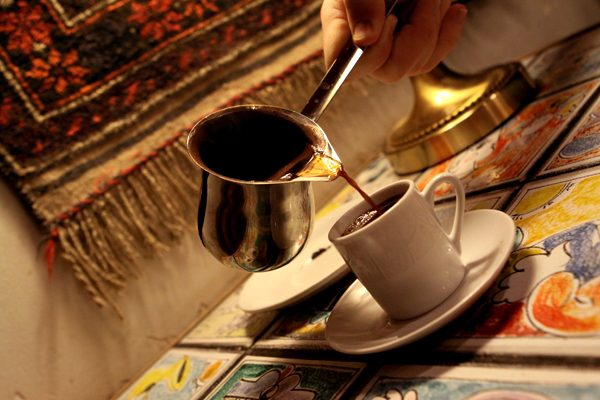
The pronunciation of the word ibrik (eeh-breek) is one of the biggest reasons why people shy away from using it to brew coffee. Also called a Cezve (jez-veh), the ibrik is designed to brew Turkish-style coffee. You can still find this old-fashioned brewing implement in active service — cafes including Cahoots Coffee Bar and Shish Cafe in St. Paul brew with ibriks. The simplicity of the ibrik reflects the origins of coffee brewing, delivering a cup where sediment is appreciated and the addition of sugar and spice adds to the balance and experience of the cup.
Holy Land Bakery and Deli carries a selection of different size ibriks along with cardamon and other Turkish spices. Although Turkish coffee can be made without the addition of sugar or spices, the sugar adds not only to the taste, but also the texture of the cup, while the cardamon helps to mellow the acidity. Prior to modern roasting techniques and green coffee growing improvements, coffee was an astringent and bitter beverage that needed the tempering influence of other flavors so that it could be enjoyed.
Brewing with an ibrik differs from other brewing methods like French Press and Pour Over Brewer because the water is brought to a boil, while most other brewing methods perform best at temperatures between 195 and 205° F. The ibrik is filled most of the way full with water and fresh, finely ground coffee. Cardamom, sugar, or other spices can also be added. The contents of the ibrik should not be stirred and space should be left near the top to allow for bubbling when boiling. Not stirring is important so that the ibrik may naturally create a crust that will harden and prevent grounds from being transferred to the cup.

The grind of the coffee is the finest grind of any other brewing methods, including espresso. Coffee should be ground to the texture of a powder so that it can dissolve and add to the texture of the cup, since there is no filter involved in the brewing process. A coffee to water ratio of 14.5 grams for every eight ounces of water (as suggested by the Specialty Coffee Association of America) should still be used as an initial measurement. As you become more proficient with the brewing method you can use more or less coffee, depending on personal taste.
After the coffee and other ingredients are added to the water, place the ibrik over medium heat and bring to a boil. Grounds will begin to moisten, and when the water begins to boil, remove the ibrik from the heat. Allow it to cool for at least one minute before returning to heat. The ibrik should be brought to a boil at least two more times.
After the third boil, coffee should be slowly poured into preheated demitasse cups. Slowly pouring the coffee will allow the grounds to catch at the rim of the ibrik, preventing most of them from being transferred to the cup. Some grounds will naturally end up in the cup, adding a thicker, grittier texture that is common and appreciated in Turkish coffee.
At Cahoots Coffee in St. Paul, owner Saed Kakish from Jordan creates his own special blend of spices for his Turkish coffee. Experimenting with various coffees, spices, and sugar will allow you to create the cup that you find the most satisfying. It is a brewing method that is far from the low acid taste of a French press or the clean taste of a pour-over brewer. It is a unique brewing process that allows texture, sugar, and spice to be appreciated.

I’ve learned in talking to friends from various middle-eastern countries that making coffee this way is highly personalized. The details can vary quite a bit. Some would read this and say: “No no no! NEVER let it boil!” Same with stirring – controversial aspect of the process. But universally, I get from all of them that coffee is all about hospitality: you visit somebody and they offer you coffee, they make it THEIR way – no special orders.
-g